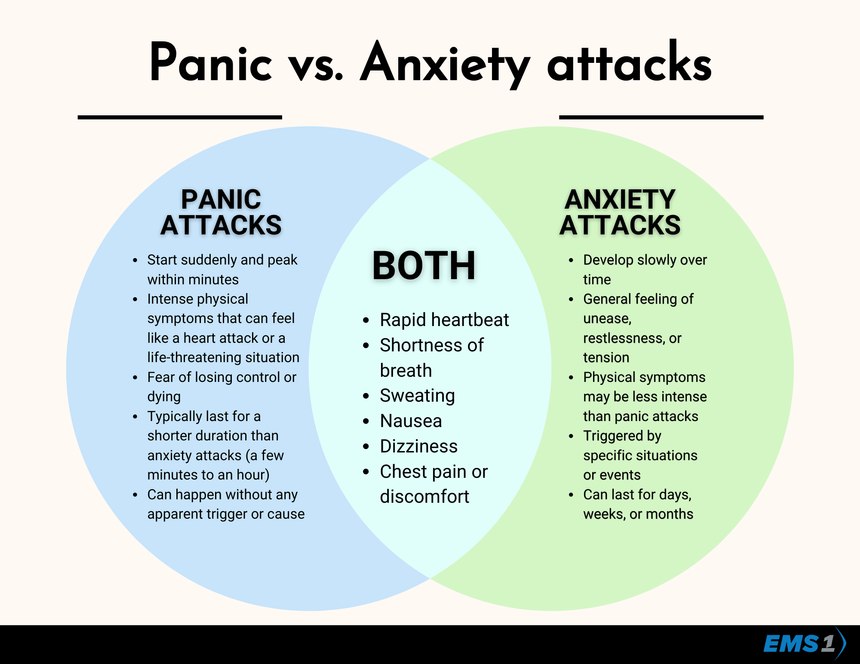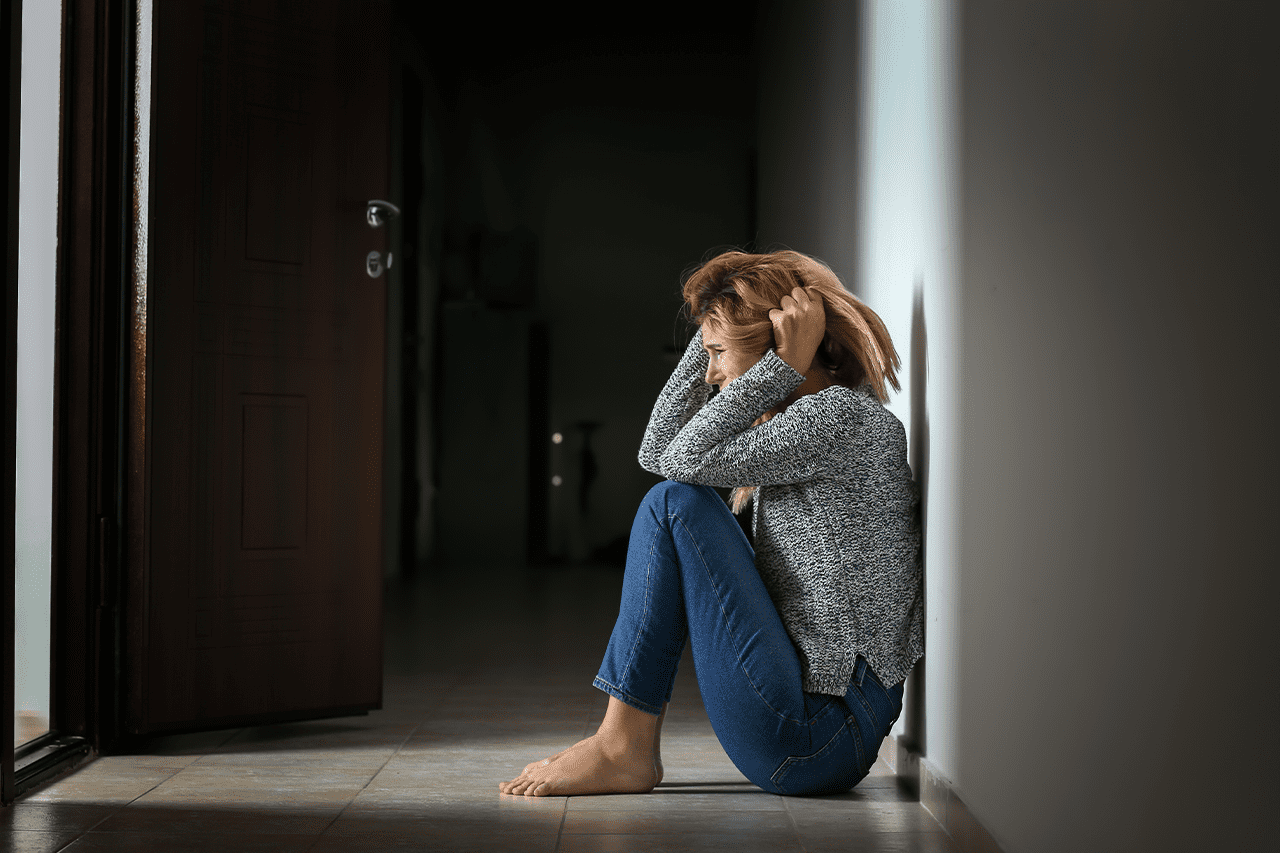Panic attacks are intense outbursts of fear or distrust that can occur unexpectedly, often for no apparent reason. These attacks can last anywhere from a few minutes to half an hour, and they usually peak within the first 10 minutes. At this time, the person may experience a variety of symptoms that are often intense and frightening, such as rapid heartbeat (tachycardia), sweating, tremors, shortness of breath, chest pain, and dizziness.
Attacks can look like a heart attack or other serious medical condition, and often cause anxiety or fear of dying. Some people experience depersonalization (separation from oneself) or derealization (feeling that the environment is unreal or alien), as well as dizziness, fever or chills, a feeling of emptiness in the head, and even fear of death.
Panic attacks may occur once in a lifetime, but if they recur, it may be a sign of panic disorder. Panic disorder is an illness characterized by frequent, unpredictable panic attacks that can have a serious effect on a person, interfering with their daily life.
Depending on the individual's sensitivity and experience, panic attacks can occur due to certain situations, stress or unexpectedly. They can occur while sleeping, at work, in public or in any other environment.
Although panic attacks can be very frightening, it is important to understand that they are not dangerous. Panic attacks are temporary and do not pose an immediate threat to life. Although panic attacks are uncomfortable, with the right treatment and strategies to manage stress and anxiety, they can be effectively controlled.

What are the causes of panic attacks?
The causes of panic attacks are not entirely clear, but they are thought to be caused by a combination of genetic, psychological and environmental factors.
Genetics: Scientists have found that genetics can play an important role in the development of panic attacks. Research shows that panic disorders are more common among those who have close relatives (such as parents, siblings) with the condition.
Psychological factors: Individuals who have previously experienced a traumatic event or suffer from other mental disorders such as depression, anxiety disorders or phobias are more likely to experience panic attacks.
Biochemical Factors: Some research suggests that certain imbalances in brain chemicals related to stress and fear regulation may be linked to the onset of panic attacks. For example, an imbalance of serotonin and noradrenaline in the brain can contribute to panic disorder.
Environmental factors: Stress, particularly intense or prolonged, can cause or worsen panic attacks. These stressors can include major life changes, such as divorce, job loss, or the death of a loved one. Also, certain situations or circumstances that cause intense excitement or fear can trigger a panic attack.
Physical health: Caffeine, alcohol, some medications and drugs, as well as certain medical conditions such as hyperthyroidism, hypoglycemia, asthma, or cardiovascular disease can trigger panic attacks.
It is important to emphasize that panic attacks can occur even without obvious reasons, so it is important to consult a health care professional if panic attacks become more frequent or interfere with daily life.
What are the symptoms of panic attacks?
Panic attacks are characterized by a variety of physical and psychological symptoms that can be very intense and often appear suddenly without warning. It is important to note that symptoms can vary from person to person and not all people experience all of these symptoms.
1. Physical symptoms:
Fast heartbeat or feeling like your heart is beating irregularly (tachycardia)
Sweating
Shaking or shaking
Breathing problems such as shortness of breath or shortness of breath
Chest pain or discomfort
Dry throat or hoarseness
Nausea or indigestion
Pain or discomfort in the stomach
Dizziness, feeling unsteady or indecisive
Chills or fever
Pain or discomfort in the muscles
Irregular or fast pulse.
2. Psychological symptoms:
Severe anxiety or panic
Fear of losing control or "getting lost"
Fear of death or fear of developing a serious illness such as cancer
Feeling that the environment is unreal, alien or strange (derealization)
Feeling that you are separated from your body or that your experiences are unreal (depersonalization).
It is important to note that although panic attacks can be very intense and frightening, they are not dangerous. Symptoms are temporary and usually go away within 10-20 minutes, although some symptoms may last longer.

Treatment
Treatment strategies for panic attacks are varied and usually include psychotherapy, medication, and various self-help strategies. Each person's treatment may vary depending on specific symptoms, health history, and other factors.
Psychotherapy: This is the first recommended treatment strategy for panic attacks and panic disorder. Cognitive-behavioral therapy (CBT) is one of the most effective forms of panic attack treatment that helps individuals understand and change the thoughts and behaviors that may cause or exacerbate panic attacks.
Medication: A variety of medications can be used to treat panic attacks, including antidepressants, benzodiazepines, and selective serotonin reuptake inhibitors (SSRIs). All of these medications can help reduce the intensity and frequency of symptoms, but they can also cause side effects, so a treatment plan should be discussed with your doctor.
Self-Treatment and Strategies: Many individuals can benefit from a variety of self-directed strategies, such as relaxation techniques (eg, deep breathing, progressive muscle relaxation), physical activity, and a healthy diet. Also, avoiding alcohol, caffeine, and drugs can reduce the frequency and intensity of panic attacks.
Group therapy and support: Participating in group therapy or support groups can help individuals who suffer from panic attacks because they can share experiences and strategies with others who are facing similar challenges.
What to do during panic attacks?
Panic attacks can be very frightening, but there are certain strategies that can help manage or reduce their intensity. Here are some tips for dealing with a panic attack:
Deep Breathing: Breathing can become shallow and rapid during a panic attack. Deep breathing can help restore a normal breathing rhythm and reduce symptoms such as palpitations, tremors, and shortness of breath. Try to breathe into your stomach through your nose, hold your breath for a few seconds, and then exhale through your mouth.
Focus on what's real: During a panic attack, you may feel disconnected from your body or your surroundings. Focusing on real, tangible things around you can help you regain a sense of reality. It can be an object you can touch or a sound you can hear.
Relaxation techniques: These may include meditation, progressive muscle relaxation, or visualization exercises. Relaxation techniques can help reduce tension and stress that can make a panic attack worse.
Remember it's temporary: Panic attacks are very intense, but they're also temporary. Remembering that symptoms will pass can help reduce fear and panic.
Get help: If you are having panic attacks and can't manage them on your own, don't hesitate to ask for help. This can be a loved one, a doctor, a psychotherapist or a support line.
How to manage panic attacks?
Panic attacks can be very frightening and disrupt your daily life, but there are some strategies and tips to manage these situations and minimize their impact.
Light therapy: Many people find it helpful to regularly spend time outside or use artificial light sources, especially if panic attacks occur during the winter months or when they are depressed.
Physical activity: Regular exercise and physical activity can help manage the stress and anxiety that can lead to panic attacks. This can be any type of activity you enjoy, such as walking, running, swimming, practicing yoga, or playing a team sport.
Healthy diet: A healthy diet can contribute to well-being and reduce anxiety. This means eating plenty of fruit, vegetables, protein, carbohydrates from healthy sources and fats, and avoiding too much caffeine, alcohol and sugar.
Sleep: Getting a good night's sleep can help reduce anxiety and stress levels. This means that you should try to get enough sleep (most adults need 7-9 hours a day), follow a consistent sleep schedule, find relaxing bedtime rituals and create a calm and relaxing bedroom environment.
Mindfulness and meditation: These techniques can help reduce anxiety and stress, as well as teach you to manage panic attacks more effectively when they occur. There are many different methods of mindfulness and meditation, such as breathing meditation, moving meditation, sound meditation, and practicing mindfulness through daily activities.
Psychotherapy and counseling: Cognitive-behavioral therapy (CBT) and other forms of psychotherapy can be very helpful for people suffering from panic attacks. A therapist can help you understand how your thoughts and behaviors can trigger or exacerbate panic attacks and teach you strategies to manage these factors.

Although panic attacks can be very difficult, many people who suffer from them are able to achieve a good treatment outcome and return to a fulfilling life with the right treatment plans and support.
Sources of information:
American Psychological Association. (2013). Diagnostic and Statistical Manual of Mental Disorders (5th ed.). Arlington, VA: American Psychiatric Publishing.
National Institute of Mental Health. (2018). Panic Disorder: When Fear Overwhelms. Retrieved from https://www.nimh.nih.gov/health/publications/panic-disorder-when-fear-overwhelms/index.shtml
American Psychiatric Association. (2017). What Are Panic Attacks? Retrieved from https://www.psychiatry.org/patients-families/anxiety-disorders/what-are-panic-attacks
Mayo Clinic. (2020). Panic Attacks and Panic Disorder. Retrieved from https://www.mayoclinic.org/diseases-conditions/panic-attacks/symptoms-causes/syc-20376021
NHS UK. (2018). Panic Disorder. Retrieved from https://www.nhs.uk/mental-health/conditions/panic-disorder/
National Institute of Mental Health. (2020). Panic Disorder: When Fear Overwhelms. Retrieved from https://www.nimh.nih.gov/health/publications/panic-disorder-when-fear-overwhelms/index.shtml
Craske, M. G., & Barlow, D. H. (2007). Mastery of Your Anxiety and Panic: Workbook. Oxford: Oxford University Press.
NHS UK. (2020). Treatment for Panic Disorder. Retrieved from https://www.nhs.uk/mental-health/conditions/panic-disorder/treatment/
# panikos atakos

